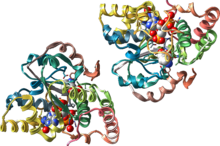
A transferase is any one of a class of enzymes that enact the transfer of specific functional groups from one molecule to another. They are involved in hundreds of different biochemical pathways throughout biology, and are integral to some of life's most important processes.

Glycosaminoglycans (GAGs) or mucopolysaccharides are long linear polysaccharides consisting of repeating disaccharide units. Except for keratan, the repeating unit consists of an amino sugar, along with a uronic sugar or galactose. Because GAGs are highly polar and attract water, they are used in the body as a lubricant or shock absorber.

Heparan sulfate (HS) is a linear polysaccharide found in all animal tissues. It occurs as a proteoglycan (HSPG) in which two or three HS chains are attached in close proximity to cell surface or extracellular matrix proteins. It is in this form that HS binds to a variety of protein ligands, including Wnt, and regulates a wide range of biological activities, including developmental processes, angiogenesis, blood coagulation, abolishing detachment activity by GrB, and tumour metastasis. HS has also been shown to serve as cellular receptor for a number of viruses, including the respiratory syncytial virus. A recent study reports that cellular Heparan sulfate has a role in SARS-CoV-2 Infection ,particularly when the virus attaches with ACE2

Sulfatases EC 3.1.6.- are enzymes of the esterase class that catalyze the hydrolysis of sulfate esters. These may be found on a range of substrates, including steroids, carbohydrates and proteins. Sulfate esters may be formed from various alcohols and amines. In the latter case the resultant N-sulfates can also be termed sulfamates.
Sulfation or sulfurylation in biochemistry is the enzyme-catalyzed conjugation of a sulfo group to another molecule. This biotransformation involves a sulfotransferase enzyme catalyzing the transfer of a sulfo group from a donor cosubstrate, usually 3'-phosphoadenosine-5'-phosphosulfate (PAPS), to a substrate molecule's hydroxyl or amine, resulting in a sulfate or sulfamate, respectively. Sulfation is involved in a variety of biological processes, including detoxification, hormone regulation, molecular recognition, cell signaling, and viral entry into cells. It is among the reactions in phase II drug metabolism, frequently effective in rendering a xenobiotic less active from a pharmacological and toxicological standpoint, but sometimes playing a role in the activation of xenobiotics. Another example of biological sulfation is in the synthesis of sulfonated glycosaminoglycans, such as heparin, heparan sulfate, chondroitin sulfate, and dermatan sulfate. Sulfation is also a possible posttranslational modification of proteins.

Alcohol sulfotransferase is an enzyme that catalyzes the sulfate conjugation of primary and secondary alcohols including many hormones, neurotransmitters, drugs, and xenobiotic compounds.
In enzymology, a [heparan sulfate]-glucosamine 3-sulfotransferase 1 is an enzyme that catalyzes the chemical reaction
In enzymology, a [heparan sulfate]-glucosamine 3-sulfotransferase 3 is an enzyme that catalyzes the chemical reaction
In enzymology, a steroid sulfotransferase is an enzyme that catalyzes the chemical reaction
In enzymology, a triglucosylalkylacylglycerol sulfotransferase is an enzyme that catalyzes the chemical reaction

Carbohydrate sulfotransferase 2 is an enzyme that in humans is encoded by the CHST2 gene.

Carbohydrate sulfotransferase 1 is an enzyme that in humans is encoded by the CHST1 gene.

Bifunctional heparan sulfate N-deacetylase/N-sulfotransferase 1 is an enzyme. In humans, it is encoded by the NDST1 gene.

Bifunctional heparan sulfate N-deacetylase/N-sulfotransferase 2 is an enzyme that in humans is encoded by the NDST2 gene.

Heparan sulfate 2-O-sulfotransferase 1 is an enzyme that in humans is encoded by the HS2ST1 gene.

Heparan sulfate glucosamine 3-O-sulfotransferase 3B1 is an enzyme that in humans is encoded by the HS3ST3B1 gene. Heparan sulfate biosynthetic enzymes are key components in generating myriad distinct heparan sulfate fine structures that carry out multiple biologic activities. The enzyme encoded by this gene is a member of the heparan sulfate biosynthetic enzyme family. It is a type II integral membrane protein and possesses heparan sulfate glucosaminyl 3-O-sulfotransferase activity ( HS3ST3A1). The Sulfotransferase domain of this enzyme is highly similar to the same domain of heparan sulfate D-glucosaminyl 3-O-sulfotransferase 3A1 and these two enzymes sulfate an identical disaccharide. This gene is widely expressed, with the most abundant expression in liver and placenta.

Carbohydrate sulfotransferase 14 is an enzyme that in humans is encoded by the CHST14 gene.

Carbohydrate sulfotransferases are sulfotransferase enzymes that transfer sulfate to carbohydrate groups in glycoproteins and glycolipids. Carbohydrates are used by cells for a wide range of functions from structural purposes to extracellular communication. Carbohydrates are suitable for such a wide variety of functions due to the diversity in structure generated from monosaccharide composition, glycosidic linkage positions, chain branching, and covalent modification. Possible covalent modifications include acetylation, methylation, phosphorylation, and sulfation. Sulfation, performed by carbohydrate sulfotransferases, generates carbohydrate sulfate esters. These sulfate esters are only located extracellularly, whether through excretion into the extracellular matrix (ECM) or by presentation on the cell surface. As extracellular compounds, sulfated carbohydrates are mediators of intercellular communication, cellular adhesion, and ECM maintenance.
N-acetylgalactosamine 4-sulfate 6-O-sulfotransferase is an enzyme with systematic name 3'-phosphoadenylyl-sulfate:(dermatan)-4-O-sulfo-N-acetyl-D-galactosamine 6-O-sulfotransferase. This enzyme catalyses the following chemical reaction
Dermatan 4-sulfotransferase is an enzyme with systematic name 3'-phospho-5'-adenylyl sulfate:(dermatan)-N-acetyl-D-galactosamine 4-sulfotransferase. This enzyme catalyses the following chemical reaction














